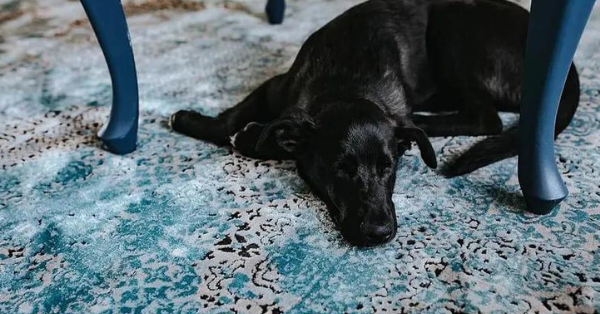More often than not, new carpets come with a unique odor. This smell may remind you of all the times you moved into a new home, or sat in a new car. Are you a carpet owner who is curious about what causes the new carpet smell and if it is dangerous to you and your family in any way? Let’s dive deeper into what the smell is and how you can safeguard yourself.
New carpet smell is caused by Volatile Organic Compounds (VOCs) that are chemicals used in the production of household materials and products like paint, wood furniture, adhesives, etc. It can cause symptoms of headaches and respiratory irritation in people. You can protect yourself from the odor by ventilating the carpeted room well for 72 hours which will accelerate the off-gassing process. Read on to find out more about this.
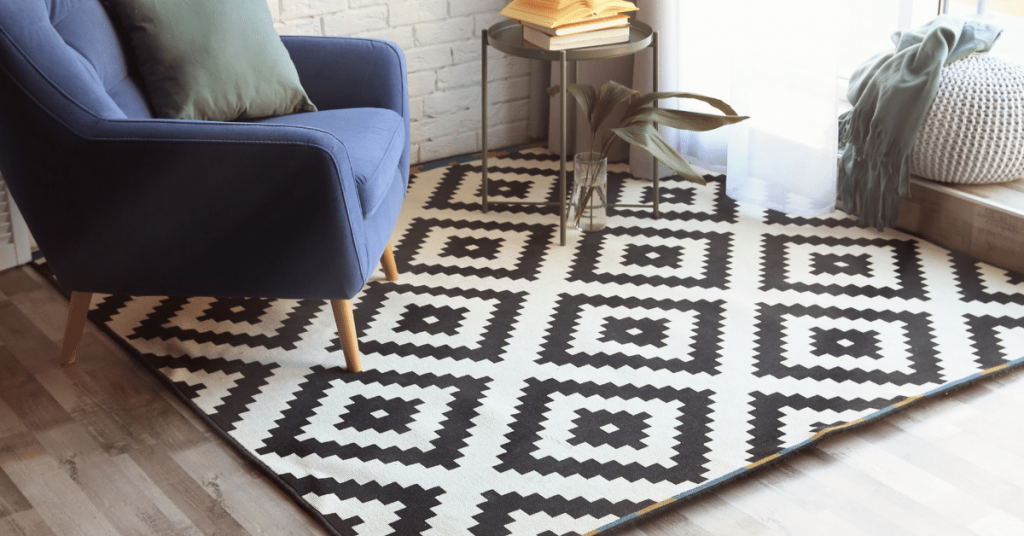
What is that smell and what causes it?
As briefly explained above, this smell is emitted from new carpets as it gradually releases the chemicals put into it during its production. Volatile Organic Compounds (VOCs) include 4-phenyl cyclohexane (4-PCH) and styrene which are present in the synthetic latex in the carpet’s backing and adhesives used in carpet installation. Other chemicals like dyes and water repellents can also be the source of VOCs if they weren’t thoroughly removed in production.
Off-gassing is the gaseous release of chemicals from any material over a period of time. The process is said to occur throughout the lifetime of a product. The “volatile” in VOCs refers to the chemicals’ ability to evaporate at room temperature which makes it easy for us to smell. The fumes disperse in the air over a few days and that is what results in the strong chemical odor.
PRO TIP
VENTILATION
Proper ventilation during the first 2-3 days of carpet installation is the #1 solution for new carpet smell.
Is it harmful?
People with issues like asthma have felt symptoms like nausea, ENT irritation, headaches and dizziness. Babies, young animals, the elderly and sensitive people are at the highest risk of suffering from symptoms. However, after thorough laboratory research and testing, it was found that the 4-PCH in carpet VOCs do not have any known link to any serious health problems. Still, as cautious customers, we must be aware of the ill-effects of these chemicals and try to protect ourselves.
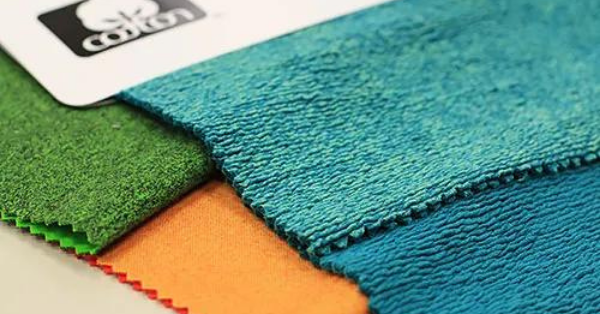
There are some consequences of being exposed to VOCs for a long time. In worst-case scenarios, mostly applicable for employees working in manufacturing factories, long-term exposure to toxic chemicals is linked to cancer, kidney and liver damage. This doesn’t mean that you can not have carpet in your homes, just that you need to take precautions to minimise exposure to VOCs.
Prevention before carpet installation
New carpet odor is not a cause for alarm but all of us react differently to different materials. Address any symptoms or discomfort by following the below-mentioned practices carefully.
1. Choose a low or non-VOC carpet
Because of a lot of flak received from consumers and advice from the EPA, carpet producers have started making carpets that have fewer chemicals in them. The beginning of reducing the amount of VOCs in your home is to buy a low or non-VOC carpet. Pick a carpet that has Green Label and Green Label Plus tags from the Carpet and Rug Institute (CRI) on it.
The CRI has stringent safety standards for the production of carpets and even vacuum cleaners. The label is used to classify carpets that produce low emissions. You can also pick a carpet that is dyed with natural colours and made of natural fibres like wool or bamboo and plant dyes. Choose carpeting that doesn’t need adhesives and can be tacked down instead.
WARNING
VOCS
Even though you will be lowering VOCs in your home by choosing a low-VOC carpet, there are other products that will contribute to the amount of VOCs indoors. Your house can not be 100% VOC-free.
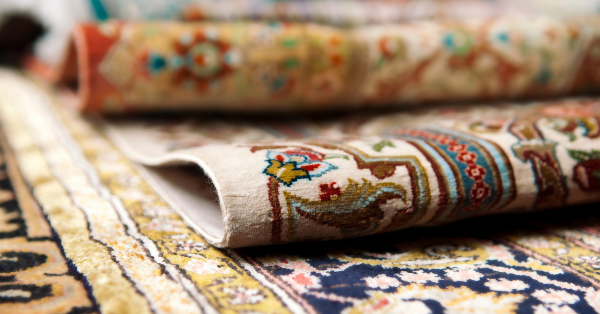
2. Use a non-adhesive installation method
Many a time, the adhesive used to glue the carpet on to the ground is the odor-causing element. You can buy a low-VOC glue or ask your carpet installer for one, or else, just use a method that doesn’t involve any glueing. You can either ask your installer for a non-adhesive method like a floating installation or tack your carpets down with the help of tack strips.
3. Install carpet in good weather
Installing your carpet around the seasons, especially during spring or fall, will allow you to leave your doors open and let it off-gas as much as possible in the first few days. This may not be very comfortable during the summer heat. VOCs can freely escape with the doors open without staying indoors for a long time which is good for you and your family.
WARNING
OFF-GASSING
Even though it is easier for you to have your windows and doors open in colder weather, off-gassing happens the fastest when the temperatures are high!
“Warehouse” your carpet
You can request your contractor to air your carpet out by leaving it unrolled for a week or so before bringing it to your house. The process is called “warehousing” a carpet. Because the VOCs released during the first few days are the strongest, this will make a considerable difference for you and the people living in your house.
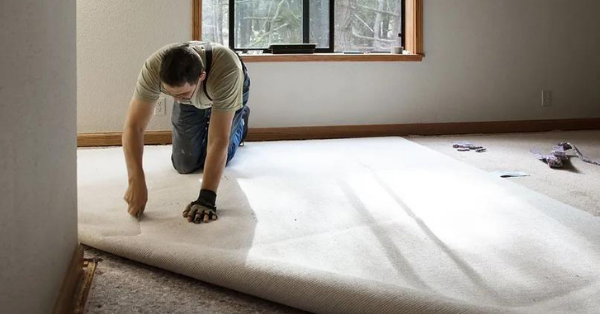
How to eliminate the new carpet smell – after installation
Now that you have understood how you can reduce the level of VOCs in your homes before carpet installation, let’s talk about methods to remove new carpet smell if you have already installed it in place.
Method 1: Let it breathe
The most important thing to do as soon as you install carpeting in your homes is to create good ventilation in order to get rid of all unpleasant odors. Leave your windows open and turn on the fans with the connecting door closed. Let your room have maximum air circulation during the strongest odor-period so that by the time you inhabit and use the room, most of the VOCs will have left the carpets and the room.
WARNING
OFF-GASSING
While a lot of posts on the same topic encourage keeping your Air Conditioners on for a long time to help accelerate the off-gassing process, I would recommend you to keep it as a last resort option as it will drive up your electricity bill and is really bad for the environment.
Method 2: Give your carpet a good vacuuming
Use a vacuum cleaning machine, preferably a green-label vacuum with HEPA filters, if available, to remove as much of the new carpet smell as you can. You should thoroughly vacuum the carpeted floor every alternate day or every day in case you live in a high-traffic home with kids and/or pets. Vacuum right after installation to remove all loose fuzz and debris.
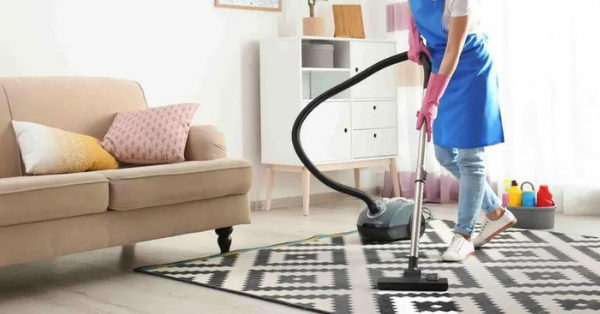
PRO TIP
ABSORPTION OF VOC FUMES
Sprinkle some baking soda on to the carpet before vacuuming to make sure maximum VOC fumes are absorbed.
Method 3: Give your carpets the sauna experience
If a really strong VOC odor still persists, use a basic steam cleaner on your own to clean your newly-installed carpet. However, it is better to avail the deep-cleaning services of an experienced professional carpet cleaner to flush out any remaining chemicals in your carpet. Hot water extraction and deep steam cleaning are effective answers to this problem.click here This is why professional carpet cleaning is better than doing it yourself.
Method 4: Green protection
Meanwhile, you can use DIY solutions to maintain the quality of air in your house. Indoor plants help filter chemicals in the air. Some plants like Boston fern, bamboo palm and English ivy help break down VOCs. Other plants like the spider plant, aloe vera and golden pothos help in clearing out the air and making your room a healthy environment by improving indoor air quality. Plants also add aesthetic value to your house apart from lessening odors.
Method 5: DIY it up – Home remedies
You can use things from your kitchen to reduce the irritating odors of a new carpet . The first and most commonly used carpet-odor-removal remedy is baking soda. Sprinkle some baking soda on the carpet and leave it on overnight before vacuuming over it thoroughly. The salt absorbs a lot of smell and you will be left with fresh-smelling carpets!

WARNING
BAKING SODA
For pet owners – the ingestion of baking soda can be dangerous to animals. Keep them away if you use this method to treat your carpets. Also, using baking soda in excess can corrode the parts of your vacuum cleaner. Use baking soda in moderation to prevent this.
If you’re steam-cleaning by yourself, add some vinegar to water to remove as much of the odor as possible. Keep tiny bowls of vinegar near parts of the carpet that have the strongest odor. Slice apples or onions and place them around the newly-carpeted room in bowls with some water. This will absorb a lot of the smell and leave your room fresh and wonderful-smelling.
Method 6: Don’t eat curry in the carpeted room
No matter how strong the new carpet smell is, do not try to mask it with food. The smell of food and cooking aromas, despite smelling good on their own, can create a foul stench, especially when combined with the smell of something else. This combination of smells will only worsen over time. Try to refrain from using any detergent while cleaning or to remove the odor as it often leaves residues and damages carpeting.
Method 7: Use an air purifier
If all else fails, fire up your air purifier to eliminate any remaining carpet smells in the air. An air purifier with an activated carbon filter can absorb and trap gaseous contaminants. You may find this feature in some air-conditioners that’ll greatly help in absorbing VOCs from the atmosphere. You can invest in an industrial air purifier that’s called an “air scrubber” costing about $500.
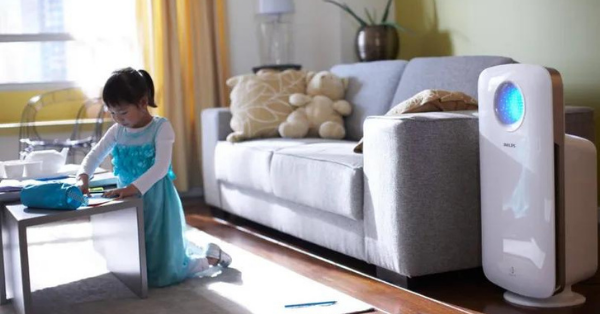
WARNING
IONIZERS
Ozone-producing ionizers will make things worse when VOCs are at their peak. Wait until the initial off-gassing period finishes to use an ionizer if necessary.
What do I do if someone is starting to feel sick?
Even though carpets are low in VOCs, in sensitive individuals, the chemicals can cause a myriad of symptoms that are uncomfortable and irritating. This is the case especially for people with asthma or other breathing difficulties. I recommend you to not panic but here’s what you can do if you or someone else is facing severe symptoms.
Hire professionals to remove the carpeting
If you are looking to remove the carpeting because of how much discomfort it is causing to you and your family, do not do it yourself. Hire professional carpet installers to do this for you as removing it on your own may release more of the VOCs, getting exposed to which you will feel worse. Let the experts take care of it while you recover from the symptoms.
Opt for a natural fibre rug/carpet as an alternative
Go for a natural fibre alternative that is not produced with a lot of chemicals and doesn’t require to be glued on with adhesives. Make sure the alternative:
1. Has been tested for VOC emissions
2. Can be cleaned and maintained easily
3. Has been unrolled prior to installation
4. Is not made of recycled synthetic materials
5. Can easily be uninstalled
6. Is made to prevent liquid penetration
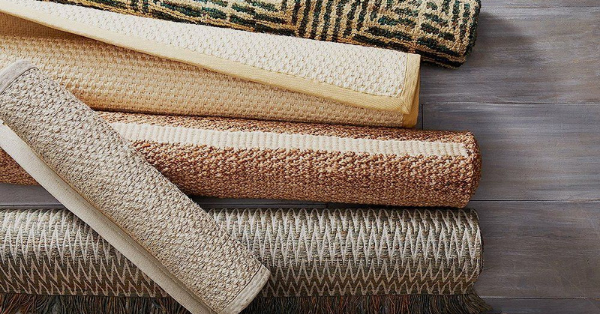
Take a short vacation
Take this opportunity to get out of the house and spend a couple of days at a friend’s house who has been asking you on a sleepover for the longest time! Plan well ahead in time and you can make this a road-trip or even head out to a resort or a spa if the first few days post-installation falls on a weekend! Leave your windows open and fans on when you’re away if it is possible.
Conclusion
Most of the time, odors from new carpets are harmless, bothersome at most. According to the Carpet and Rug Institute, carpets emit the lowest amount of VOCs compared to other items in your house. This is why they have a very small chance of causing any risk to humans and animals.
With good ventilation and air circulation, the odor is eliminated within a week or two. Even if it still persists, you can make use of the above-mentioned tips to get rid of the new carpet smell. Use the prevention tips before you install a carpet the next time and enjoy your safe new carpet!
